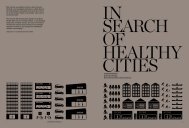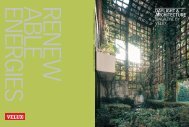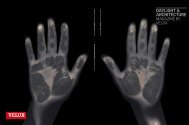Download as PDF - Daylight & Architecture - Magazine by | VELUX
Download as PDF - Daylight & Architecture - Magazine by | VELUX
Download as PDF - Daylight & Architecture - Magazine by | VELUX
You also want an ePaper? Increase the reach of your titles
YUMPU automatically turns print PDFs into web optimized ePapers that Google loves.
Imagining Light:the me<strong>as</strong>ureableand the unme<strong>as</strong>urableof daylight designThe art of daylighting involves much more than merely allowing the rightamounts of natural light into a building. Acts of great architecturalimagination may transform the utilitarian functions of daylighting – theme<strong>as</strong>urable – into places of great beauty – the unme<strong>as</strong>urable. To get abetter understanding of these strategies, it is helpful to look at m<strong>as</strong>terpiecesof daylight and architecture in greater detail.By Dean HawkesPhotography <strong>by</strong> Gerry Johansson“<strong>Architecture</strong> comes from the making ofa room. A room is not a room withoutnatural light.”Louis KahnIn this deceptively simple statement,Louis Kahn lays down a profound challenge.The implication is that light inarchitecture is needed not only to servepractical purposes, but is the key to thedefinition of architecture itself.One of the most important achievementsof nineteenth- and twentieth-centuryapplied science h<strong>as</strong> been to quantify andcodify human requirements in buildings.This h<strong>as</strong> been particularly successful inthe field of lighting design, where standardsof illumination, design proceduresand rules-of-thumb are to be found inmany design manuals and guidebooksFamiliar rules-of-thumb include geometricalformulae, such <strong>as</strong> the ‘no-skyline’, where the depth of penetration ofthe visible sky is taken to indicate thelimitation of the daylit area of a room.Others are expressed in simple equationsin which the daylight factor in a room isrelated to the ratio of window area to floorarea. These tools are of immense utilityand place practical design on solid foundations.In recent years, they have beencomplemented <strong>by</strong> the development ofcomputer-b<strong>as</strong>ed calculation methodsand simulation tools.But there is much more to daylightingdesign than this and, once again, it is LouisKahn who gets to the nub of the matter.“I only wish that the first really worthwhilediscovery of science would be that it recognisedthat the unme<strong>as</strong>urable is whatthey’re really fighting to understand, andthat the me<strong>as</strong>ureable is only the servantof the unme<strong>as</strong>urable; that everything thatman makes must be fundamentally unme<strong>as</strong>urable.”Here Kahn presents a conundrum. Whatis the value of quantification and codification,the me<strong>as</strong>ureable, if we are reallyseeking to understand the essence of architecture,the unme<strong>as</strong>urable? How maywe solve the puzzle?It is a truism that architecture is acombination of art and science. This isclearly reflected in the conventional categoriesof architectural literature and inthe curricula of schools of architecture,where the two realms all too often remainfirmly separate. But this does not help usto solve Kahn’s conundrum, so where dowe look?Christopher Wren:geometry and lightMy solution is that, whilst <strong>as</strong>pects of artand science certainly pertain to questionsof architecture, it is not possible to constructa proper understanding of its truenature <strong>by</strong> applying a simplistic equationof the form – art + science = architecture.In the search for an answer, we shouldturn to the evidence of buildings themselves,of works of architecture, and ofthe statements of architects of substance,which, if correctly interpreted, providedeep insights into the matter. I propose amode of architectural analysis that allowsus to look directly into Kahn’s architecturalunme<strong>as</strong>urable.In my book The Environmental Imagination,I made studies of works <strong>by</strong> significantarchitects whose work spannedthe nineteenth and twentieth centuries,precisely paralleling the period whenthe quantification of environmentaldesign occurred. In recent work, I havepushed back the historical time frameto explore works from the sixteenth tothe eighteenth centuries. In all of this Ihave argued that the crucial instrumentof understanding, of looking into the unme<strong>as</strong>urable,is that of the imagination,defined <strong>by</strong> my dictionary <strong>as</strong>, ‘the facultyof forming new ide<strong>as</strong>’. To illustrate mymeaning, let’s consider some buildingsthat demonstrate the application of imaginationin the conception of daylight.The first c<strong>as</strong>e is from the works of SirChristopher Wren. He w<strong>as</strong> both scientistand architect and, before his first works<strong>as</strong> an architect, he held professorships of<strong>as</strong>tronomy, first in London and then inOxford. In a forthcoming book I explorethe relationship between Wren’s scienceand his architecture and propose that heachieved a profound reconciliation ofthese two fields, of the me<strong>as</strong>urable andthe unme<strong>as</strong>urable. One of Wren’s greatestarchitectural achievements w<strong>as</strong> thereconstruction of over fifty Londonchurches, following the dev<strong>as</strong>tation of the27










